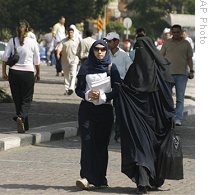Cairo, Egypt
07 October 2009
 |
| An Egyptian woman, right, wears a "niqab" a veil which shows only the eyes, as she walks with another, wearing the "hijab", or headscarf, left, in downtown Cairo, Egypt (file) |
What are Egyptian women wearing?
Stand on any street corner in Cairo and you are likely to see a wide range of female attire. A middle-aged woman in a loose, long dress is wearing a brightly colored headscarf. She stands beside teenage girl, whose head is covered too, but is sporting a figure-hugging top and skin-tight jeans. Next to her is a woman in billowing head-to-toe black, her kohl-rimmed eyes the only part of her body exposed to the world.
Egypt is a deeply religious, modern society. Here there is choice, unlike, for example, in Saudi Arabia, where cloistered, covered women have little say in the matter.
But the Saudi-style clothing of the fully covered woman is an increasingly common sight in Cairo, one that has both leading clerics and secularists alarmed.
Cause for alarm?
Hala Mustafa, a senior editor at Al-Ahram media, is among those concerned about the growing trend of covering up. She sees its roots in the conservative Saudi brand of Sunni Islam.
 |
| A woman in Cairo wears the full veil, or niqab, an increasingly common sight in the Egyptian capital, 7 Oct. 2009 |
Mustafa says the increasing use of coverings does not mean Egypt is becoming more religious, simply more conservative and dogmatic.
Television influence
Some of that conservatism comes from what was once considered orthodoxy's biggest threat -- satellite television channels which, along with a stream of unfettered Western sexuality, offer a wide variety of religious programming.
 |
| A young Cairene observes the tradition of modesty with her head covering, 7 Oct. 2009 |
El-Mograbi says satellite programs have brought about an increase in religious awareness and enlightenment. She notes that, in the past, you had to go to the mosque to hear religious preaching, while now you can get everything you need at home.
The influence is apparent in even the smallest village, where the growth of satellite dishes parallels the surge in women donning the full veil. How much the trend originates with the women is a matter of debate.
Personal choice
Although el-Mograbi welcomes the trend of covering up, she feels the decision is meaningless unless it is a personal one. And, to her, it is not just a question of modesty. Her shop, with its luxe scarves and beautifully-cut long dresses, caters to the cosmopolitan Cairene.
The shop-owner says she believes the veiled woman needs to care more about her attire. She says women who do not wear the veil have their hair to make them look good. So, she says she prefers coupling fashion and the veil because they are parallel. It is a sentiment seemingly at odds with the desire to be undesirable.
Back to that woman on the street corner -- the one in all-encompassing black right down to her gloved hands. As she steps off the curve, she reveals a flash of delicately-beaded, black high heels. They are exquisite enough to provoke an impious emotion: envy.